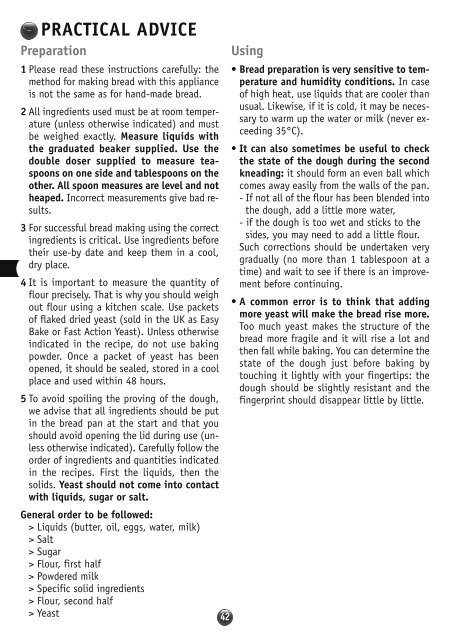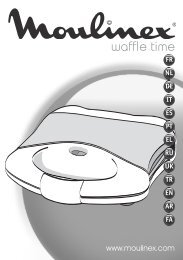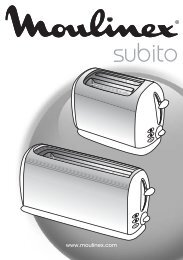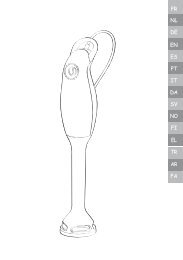home bread - bineo
home bread - bineo
home bread - bineo
Create successful ePaper yourself
Turn your PDF publications into a flip-book with our unique Google optimized e-Paper software.
PRACTICAL ADVICE<br />
Preparation<br />
1 Please read these instructions carefully: the<br />
method for making <strong>bread</strong> with this appliance<br />
is not the same as for hand-made <strong>bread</strong>.<br />
2 All ingredients used must be at room temperature<br />
(unless otherwise indicated) and must<br />
be weighed exactly. Measure liquids with<br />
the graduated beaker supplied. Use the<br />
double doser supplied to measure teaspoons<br />
on one side and tablespoons on the<br />
other. All spoon measures are level and not<br />
heaped. Incorrect measurements give bad results.<br />
3 For successful <strong>bread</strong> making using the correct<br />
ingredients is critical. Use ingredients before<br />
their use-by date and keep them in a cool,<br />
dry place.<br />
4 It is important to measure the quantity of<br />
flour precisely. That is why you should weigh<br />
out flour using a kitchen scale. Use packets<br />
of flaked dried yeast (sold in the UK as Easy<br />
Bake or Fast Action Yeast). Unless otherwise<br />
indicated in the recipe, do not use baking<br />
powder. Once a packet of yeast has been<br />
opened, it should be sealed, stored in a cool<br />
place and used within 48 hours.<br />
5 To avoid spoiling the proving of the dough,<br />
we advise that all ingredients should be put<br />
in the <strong>bread</strong> pan at the start and that you<br />
should avoid opening the lid during use (unless<br />
otherwise indicated). Carefully follow the<br />
order of ingredients and quantities indicated<br />
in the recipes. First the liquids, then the<br />
solids. Yeast should not come into contact<br />
with liquids, sugar or salt.<br />
General order to be followed:<br />
> Liquids (butter, oil, eggs, water, milk)<br />
> Salt<br />
> Sugar<br />
> Flour, first half<br />
> Powdered milk<br />
> Specific solid ingredients<br />
> Flour, second half<br />
> Yeast<br />
42<br />
Using<br />
• Bread preparation is very sensitive to temperature<br />
and humidity conditions. In case<br />
of high heat, use liquids that are cooler than<br />
usual. Likewise, if it is cold, it may be necessary<br />
to warm up the water or milk (never exceeding<br />
35°C).<br />
• It can also sometimes be useful to check<br />
the state of the dough during the second<br />
kneading: it should form an even ball which<br />
comes away easily from the walls of the pan.<br />
- If not all of the flour has been blended into<br />
the dough, add a little more water,<br />
- if the dough is too wet and sticks to the<br />
sides, you may need to add a little flour.<br />
Such corrections should be undertaken very<br />
gradually (no more than 1 tablespoon at a<br />
time) and wait to see if there is an improvement<br />
before continuing.<br />
• A common error is to think that adding<br />
more yeast will make the <strong>bread</strong> rise more.<br />
Too much yeast makes the structure of the<br />
<strong>bread</strong> more fragile and it will rise a lot and<br />
then fall while baking. You can determine the<br />
state of the dough just before baking by<br />
touching it lightly with your fingertips: the<br />
dough should be slightly resistant and the<br />
fingerprint should disappear little by little.





